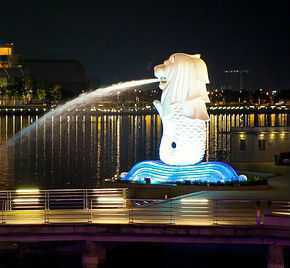 Thinking of spending a day in Singapore, what comes to mind for most tourists is staring at the infamous Merlion, and the mystique of the half-lion and half-fish chimera. It’s good news for Singaporean tourism, which is proving successful in searing the wonders of the country’s icon into the minds of intrigued outsiders.
Thinking of spending a day in Singapore, what comes to mind for most tourists is staring at the infamous Merlion, and the mystique of the half-lion and half-fish chimera. It’s good news for Singaporean tourism, which is proving successful in searing the wonders of the country’s icon into the minds of intrigued outsiders.
As any inquisitive person with a penchant for mystery would, you can’t help but ask: what is a Merlion? And what significant role does it play in portraying Singaporean history and identity?
The Lion City: transcendence of past across time
The lion and fish hybrid is actually an amalgamation of the island’s legend and form of livelihood. Before British colonisers came to invade Singapore, it wasn’t Singapore yet. Instead, history hailed it as Temasek, meaning “sea town”, which had numerous ports open to international maritime trade. It makes sense that the city would use the fish to allude to their economic history. But how does the lion come into play?
A Serajah Melayu legend has it that a prince from Palembang, Sang Nila Utama, met a lion upon landing on the shores of Temasek. This made him rename the city to Singapura, which translates to “lion city” in Sanskrit.
Using the Merlion as a symbol of the island’s history and literary narrative can be viewed as a tribute and honour to the island’s beginnings. The interesting part is that to this day, the Merlion draws foreign interest and attention to the city, making it one of the world’s most in-demand and beloved tourist attractions.
The Merlions of the City: history across space
There are seven Merlions approved by the Singapore Tourism Board. The oldest statue was unveiled in 1972, and one of the newer statues, the tower in Merlion.sentosa.com.sg, became available for public viewing in 1995. The 37-metre building stands on a hill 23-metres above sea level, and has 12 floors, including the observation deck at the top where visitors can view the city skyline.
Designed by Australian sculptor James Martin, the cement tower comes with a thin shell of concrete built in with 16,000 lights that trace the outline of the sculpture, and a pair of eyes that project multi-coloured laser beams. Another thing that makes this structure unique is its emphasis on the intricacies of the Merlion’s facial expressions.
Now, Merlion also appears in China, Japan and Shenzhen, spreading Singaporean cultural depth and significance.

